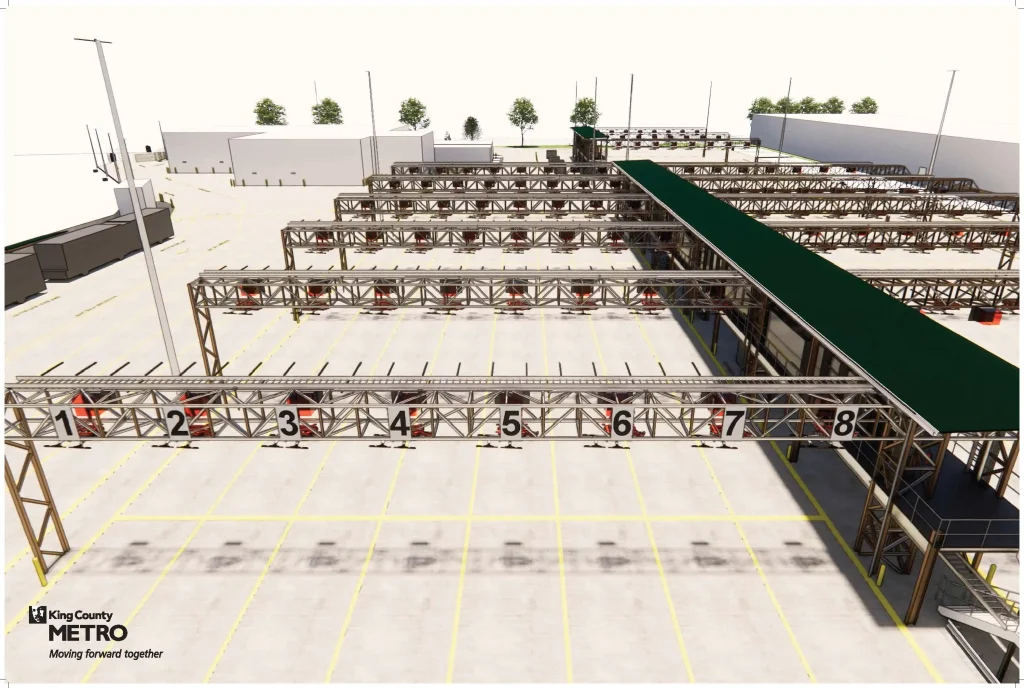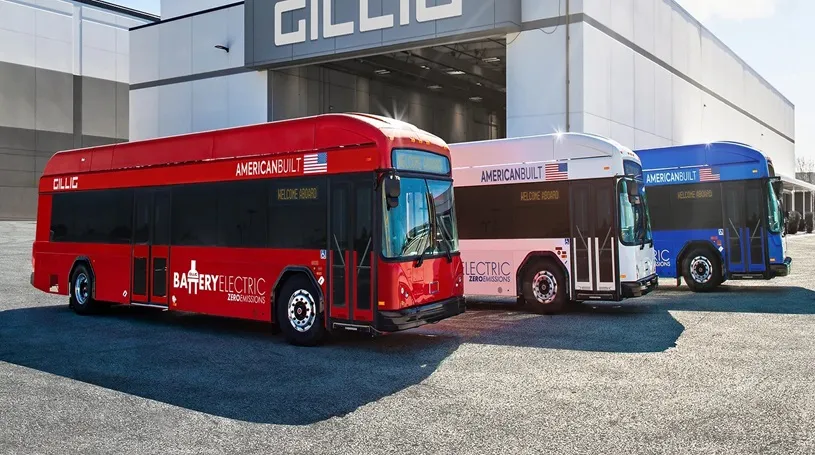
King County Metro broke ground on a new zero-emissions bus base facility in Tukwila this month. Known as Interim Base, the facility will house 120 battery-electric buses (BEBs) currently on order and arriving in a few short years.
“As we transition to a zero-emission fleet, the new Interim Base in Tukwila will be the blueprint to construct future bases and will be a hub of innovation,” Michelle Allison, Metro’s General Manager, said in a statement. “New zero-emission vehicles and our world-class technicians and other transit professionals will soon be here.”
Metro’s new Interim Base grows in Tukwila
Interim Base will span 12.5 acres with new maintenance spaces and vehicle charging equipment. Situated just south of Metro’s current charging test facility for 40 BEBs, Interim Base is going to be a big departure from the past and not just because of its electrification focus.
Metro plans to invest in numerous sustainability features at Interim Base, such as more reflective concrete instead of black asphalt to reduce the heat island effect and installation of drought-tolerant plants to reduce water use. Consequently, the project is expected to score at the LEED Platinum certification level, as required by the county’s Green Building Ordinance.
The new base will also look and operate definitively different from conventional bus bases with rows of overhead structures. Those structures will hold the charging equipment, which can be lowered to directly connect to the battery systems on top of buses. And new software technology will support management of equipment and efficient site operations.

In total, the base will pull six to ten megawatts of electricity from the grid to charge vehicles. That’s a significant amount of electricity, enough to charge 6,000 to 10,000 homes at a time. Electricity for the facility is being provided from Seattle City Light (SCL), which uses clean and renewable energy. Most SCL electricity comes from hydro power but also partially from wind, nuclear, and biogas power. (Metro facilities on the Eastside, however, are powered by Puget Sound Energy, which primarily sources its electricity from dirty power like coal and natural gas.)
Interim Base is expected to open in 2026, just in time for a new fleet of BEBs arriving. Metro plans to store 100 40-foot and 20 60-foot BEBs at the facility. Deliveries of the next 90 BEBs is expected to begin in mid-2025 and wrap up by early spring in 2026.
The new fleet of BEBs is intended to serve routes in South King County to achieve racial and economic equity objectives. Due to their proximity to major trucking routes and high volume highways, those communities suffer from high levels of pollution and associated respiratory diseases. Metro hopes to help alleviate the problem with the electric buses — though electrifying freight and general traffic would be needed to finish the job.
Metro does plan to deploy more BEB charging and storage facilities in the coming years as the agency transforms to a 100% zero-emissions fleet by 2035. The next project will be nearby at the South Base Annex, scheduled to start construction in 2025 and open sometime in 2028. That facility will be capable of storing another 250 BEBs. However, a brand new base for 250 BEBs in Kent or Auburn was suspended several years ago.
Interim Base is coming at a hefty cost, clocking in at $115 million. $90 million is for construction and an additional $25 million in costs derive from permitting, design and engineering, and electrical infrastructure installation. Grants are only paying for a small share of the project with $7.95 million from the Federal Transit Administration and another $14.3 million from three state grant programs.
Battery buses do have their challenges
However, there are some serious drawbacks with rapid deployment with BEBs due to cost and operational challenges.
Charging equipment and base retrofits can come with significant upfront costs — as evidenced with Interim Base — and procurement costs of BEBs can be a third or half more than diesel hybrid buses. Collectively, that can be a significant barrier to electrification.
Transit agencies are heavily relying on federal grants to defray added electrification costs, but that’s dependent on the grant spigot to keep flowing. With the White House and Congress up for grabs this year, the future of federal grants is on shaky ground. Fortunately, grants from the state are another potential avenue to pay for electrification. Washington’s new Climate Commitment Act — which is now in the crosshairs of activist conservatives — is funding a variety of transportation electrification efforts, including transit buses.
Metro has been fortunate in routinely winning competitive federal grants. Earlier this month, the agency secured a $33.5 million federal Low or No Emission Grant to pay for electrification efforts benefiting 27 bus corridors. The agency also touted this week $61 million in federal grants to support procurement of 89 BEBs from Gillig, a California-based bus manufacturer. That procurement is expected to cost $111 million, and provides the agency with options to purchase another 395 BEBs over the next five years.
The operating difficulties of BEBs are also significant due to their shorter range compared to diesel hybrids, poor performance in cold weather, and need for more vehicles due to recharging time. Transit agencies are trying to offset some of these problems with fast charging equipment on-route and specialized techniques.
Inductive wireless charging is a promising solution, but is an added cost and not necessarily foolproof. Sound Transit is paying $3.5 million for 13 in-ground 300 kilowatt inductive wireless chargers to benefit its new Stride bus lines coming into service later this decade. The agency says that it does take quite a bit of time to get a big charge.
“Theoretically, the Stride buses would be able to get from 20% to 80% state of charge using the InductEV fast chargers in around 2 to 2.5 hours,” said Rachelle Cunningham, a Sound Transit spokesperson. “The speed of charge starts to taper off as the bus gets closer to 100% to maintain battery health.”
In practice, Sound Transit only expects to charge for short spurts of about 10 minutes or less at layover spots, allowing for buses to regain some juice in the batteries. “Longer charges (i.e., bringing the buses up to 100%) will occur during midday or overnight at the bus base with slower, plug-in chargers,” Cunningham said.
For now, Metro appears to be focused on a base charge and dispatch model, which could affect practical operations. “How quickly the BEBs will charge will depend on several factors, including the state of charge when the vehicle arrives at the base,” Al Sanders, a Metro spokesperson said. “Currently the charging range is three to six hours.”
Modern diesel hybrids like the 40-foot and 60-foot New Flyer Excelsiors Metro uses typically carry enough fuel to run a whole day of service.
However, Sanders said that experience with test BEBs hasn’t affected operating needs for chosen routes. “The New Flyer BEBs at our South Base Test Facility are scheduled to operate on short service blocks (under 140 miles) that were previously operated by diesel hybrids,” Sanders said. “The vehicle requirement for this service is the same for diesel hybrids and New Flyer BEBs.”
Nevertheless, many transit agencies are pulling back from visions of rapid BEB deployment. Even in California’s progressive-dominated Bay Area, transit agencies mandated to reach state zero-emission vehicle goals by 2040 are opting for alternatives like hydrogen fuel cell buses or taking a cautious, slow process to convert their fleets to BEBs. That’s not dissimilar to Community Transit in Snohomish County, which is testing out both technologies and set a 2044 fleet conversion goal. And late last month, Milwaukee’s transit agency was only the latest to completely ditch BEBs, after only a short period of use due to market conditions and performance issues.
Metro leadership, however, remains steadfast in BEB expansion as its primary electrification strategy. Time will tell how that plays out.
Stephen is a professional urban planner in Puget Sound with a passion for sustainable, livable, and diverse cities. He is especially interested in how policies, regulations, and programs can promote positive outcomes for communities. With stints in great cities like Bellingham and Cork, Stephen currently lives in Seattle. He primarily covers land use and transportation issues and has been with The Urbanist since 2014.


